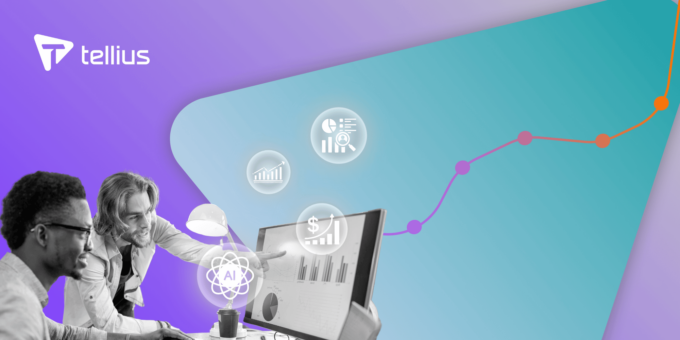Augmented Analytics: How AI is Transforming BI to Keep Pace With Complex Data

Data drives all good decision-making. It highlights problems, points to new opportunities, and helps us diagnose changes in performance, so we can more easily progress toward desired goals and benchmarks. But as the complexity of data has grown, extracting valuable insights with traditional business intelligence platforms (BI) and self-serve BI has become more difficult. And often, it’s left businesses with the choice to either sacrifice the quality of their insights by confining the analysis to a select number of variables or to sink large amounts of time into data preparation, analysis, and model building to get the in-depth, granular information needed. The reality is, no business can afford this trade-off, though. The time-to-insight has to be short if you want to take full advantage of new opportunities. And you have to utilize all the data available to you to make the best decision. In this article, we’ll examine the transformative architectural shift taking place in business intelligence, discuss the ins-and-outs of augmented analytics, and dig into the use cases and benefits of the technology today.
What is Augmented Analytics?
A term originally coined by Gartner, augmented analytics uses machine learning (ML), artificial intelligence (AI), and various natural language processing (NLP) technologies (like natural language generation and natural language query) to accelerate and improve data analytics. As the newest wave of BI technology, it builds on and enhances old models of data analysis to make insights accessible to all types of business users, including those without extensive technical skill or know-how. In fact, with augmented analytics, data analysts and citizen data scientists can actually extract deeper, more granular insights in minutes than a professional data scientist might be able to in the same amount of time with a traditional BI solution.
The 3 Generations of BI
Business intelligence is most easily divided into three generations of technology, each defined by the accessibility, speed, size of dataset, and quality of insights the solution offers.

Traditional Business Intelligence
Traditional business intelligence is considered the oldest version of BI -- and the least user-friendly. Built on legacy infrastructure that required IT professionals to aggregate data and structure OLAP cubes for analysis, traditional BI delivered reports and static dashboards as its primary outputs. From pulling the data from databases manually and cleaning it by hand to building models, mining data, and generating the data-rich reports that departments and teams across the organization needed -- everything was handled by the experts. The biggest problem with this was that it took weeks to deliver critical insights to the business, because IT was needed to design models and reports. And since the system only provided a retrospective view on queries, they couldn’t offer predictive insights. As a result, decision-makers were ultimately left to “go with their gut” on new opportunities and solutions to major problems.
Self-Service Business Intelligence
Self-service business intelligence (SSBI) solutions offer significant upgrades to the traditional model of data analytics. Most notably, they allow data analysts and other business users to create their own reports and data visualizations using the models built by IT. Being accessible to everyone in the organization on-demand, this approach to BI enables users to create ad hoc reports, ask follow-up questions, and manually dig deeper into the insights for more targeted information. Unfortunately, self-serve still can’t solve the last mile problem, because it’s visualization interface for data exploration uses traditional drag-and-drop measures and dimensions, which are complicated for business users. And as the volume and complexity of data has grown, it’s become impossible (even for expert data analysts) to use self-serve BI tools to manually analyze every combination of data points to find important insights.
Augmented Analytics
As the next generation of business intelligence, augmented analytics improves the self-serve model in several distinct ways. Using artificial intelligence, it simplifies data prep by automatically sourcing data from various databases and integrated tools. And once the data is in the platform, it allows users to self-serve ad hoc reports on a conversational UI using natural language queries. Augmented analytics doesn’t just simplify data analysis on the backend. It also delivers insights and visualizations via natural language generation (NLG) to make data more accessible and valuable to the average user. The software also slices and dices the data in real-time to provide insight into the “why” behind the reported information -- not just the what, who, and when. And, over time, the algorithm develops a deeper understanding of user intent, which allows it to deliver more targeted and nuanced answers to complex questions. Together, these features allow data analysts and citizen data scientists to design custom visualizations and generate insights faster and more easily than ever before.
How Does Augmented Analytics Work?
While similar to other forms of BI in its analytics workflow, augmented analytics also enhances the four major stages of data analysis using ML, NLG, and AI. Here’s how:

Data Preparation
Data preparation is all the work you do to get your data ready for query and analysis. It involves the collection, cleaning, connection, and validation of datasets. And often, it requires the expertise of developers and data scientists to complete.However, with augmented analytics tools, you can automate data preparation and simplify integrating with all of your data sources -- including data warehouses like Amazon Redshift, cloud platforms like Salesforce, web service tools like Amazon S3, and analytics platforms like Google Analytics. When the data (and metadata) has been added to the pipeline, everything from data cleaning to dataset unification is done for you, automatically. This makes it possible for your data scientists, data engineers, and developers to focus on creating new analyses to deepen insights.
Insight Discovery
Insight discovery is the step in the data analytics process where the algorithm analyzes the data through the lens of a predefined model to find answers to questions, such as quarterly revenue or customer acquisition rates. However, because models traditionally have to be developed manually by data scientists, insights can be lacking in specificity.With augmented analytics, insight discovery is both easier to initiate and more thorough. Queries can be made using natural language and voice inputs instead of hyper-specific keyword entries, and machine learning algorithms can dig through all of your data (no matter how many rows there are) to find detailed, targeted insights to answer your question.
Insights Sharing
Insights sharing is the process of delivering insights to the end-user via reports or visualizations. Typically, this requires IT teams to generate data reports and create charts and graphs by hand for business users to interpret and use. However, with augmented analytics, time-to-insights and human effort can both be reduced dramatically. Using natural language generation, augmented analytics platforms deliver insights in real-time that can be viewed from an online dashboard. These insights include both the direct answer to the natural language query and the reasoning for the answer. This means your decision-makers can consider all relevant factors before moving forward with their decision and can effectively share the knowledge across your organization to achieve better overall outcomes.

What Are the Benefits of Augmented Analytics?
Real-Time Insights
Unlike traditional BI and self-serve analytics software which requires extensive amounts of time (either on the frontend, backend, or both) to work properly, augmented analytics solutions can deliver insights in minutes. All a user has to do is ask a question and hit enter. The AI will mine billions of rows of raw data in milliseconds, using its ML models, and generate comprehensive, natural language insights and visualizations to help the user understand exactly what’s going on. And since the insights are delivered in real-time, business users at every level can use them to capitalize on time-sensitive opportunities.
Deeper Analysis
Getting into the nitty-gritty details of your data to extract valuable insights has always been a challenge. With augmented analytics, you can zoom in to the most granular level of your data by automatically querying billions of data points and dozens of different variables in seconds. This, in turn, enables you to access more accurate insights, delve into the “why” behind the result, and make better predictions for future outcomes.
Democratization of Data
While previous iterations of BI technology required IT teams to do the heavy lifting, augmented analytics software frees up your data scientists and data analysts to spend time on more important work. Using augmented analytics, anyone in your organization (no matter their data or coding skill set) can access granular insights in real-time and create custom visualizations to better interpret the data. As a result of this increased data democratization, augmented analytics solutions are predicted to lift the organizational adoption of BI from 30% to 50%.
Break Down of Data Silos
When using traditional and self-serve BI, individuals and teams require custom models to answer their unique queries. But the problem is: these models don’t always account for all the data available. For example, a marketing team may request that data be analyzed using a specific KPI and request that the data be pulled from their cloud-based CRM and analytics tools. But without data from sales and customer support, they might miss out on key opportunities to enhance their marketing campaigns. At the same time, the valuable insights generated by the marketing team might not make it outside of their network -- which means both the data and its insights will be confined to an organizational silo. Augmented analytics completely upends this paradigm by creating a shared collection of data and insights for your entire organization. When a natural language query is made, datasets from all integrated platforms, databases, and big data storage locations are analyzed to deliver a comprehensive answer. Meanwhile, the ML models are updated each time a query is made to reflect the new connections between datasets -- and all of it can be leveraged by anyone in your organization for their own queries. Since the insights and visualizations can also be shared directly between teams and departments via dashboards, your employees can effectively work cross-collaboratively on multi-departmental projects too.
Better Business Decisions
When you have to wait weeks to get mission-critical insights, you can easily miss your window of opportunity. But, if you try to rush the process, you can end up missing crucial details hiding in the data. By analyzing billions of records in seconds, augmented analytics solves both of these problems easily. Besides that, it goes one step further to highlight the “why” behind each insight and give business users the nuanced knowledge they need to make smart decisions.

Use Cases of Augmented Analytics
Here are some use cases to show you how augmented analytics works in the real world.
For Pharmaceutical Companies: Optimize Go-to-Market Strategies
Between prescriber, patient and market share data, pharmaceutical and biotech companies need a lot of data to build successful market access strategies with better commercial insights. With augmented analytics, organizations have drastically cut down on the time spent analyzing data (including large datasets from third-party and internal sources) by automating data analysis with AI-driven techniques. Users instantly dig deeper to discover the reasons behind the peaks and valleys of performance. Meanwhile, data analysts and business teams alike can quickly glean natural language insights and make mission-critical decisions instead of coding.As an example, a Top 5 Big Pharma company has managed to process its data 20x faster and reduce its data analysis time by 98%, through the use of augmented analytics. As a result, they’ve been able to save millions of dollars in loss reduction.
For Financial Lenders: Assess Credit Risk
Whether reviewing a mortgage loan, a car loan, or a small business loan application, financial lenders need to be able to assess customer risk to minimize the likelihood of bad investments and defaults. With augmented analytics, it’s possible to conduct a thorough analysis of all relevant data points, and, in minutes, determine the customer attributes and behaviors tied to higher risk. ML algorithms automatically assess every combination of data points to evaluate risk and identify key attributes like age, credit score, amount of savings, and more that contribute to that risk -- eliminating the need to slice-and-dice data manually. This enables lenders to make the best decisions regarding loan approval and loan amounts while getting qualified customers approved faster. In fact, using augmented analytics, a Top 10 financial services firm was able to analyze 300+ variables 10x faster than they had when they cleaned and analyzed the data by hand. As a result, they were able to get back thousands of hours in productivity and save over $700k per month in credit losses.
Consumer Goods Companies: Keep Customers Happy
Data plays a key role for consumer goods businesses and retailers as it shapes decisions for marketing, sales, and customer service activities. Augmented analytics generates insights on product sales, customer churn rate, customer satisfaction, and cart abandonment in real-time. With natural language generation, insights aren’t delivered in messy Excel spreadsheets or data-heavy reports. Instead, key metrics are provided in graphical charts and supplemented natural language, which enables brand managers and sales teams to quickly find the answers they need.
At the same time, augmented analytics allows them to pinpoint anomalies and discover the reasons behind certain outcomes and customer behaviors, so they can better engage customers and keep them happy.
A Fortune 100 company saw this first-hand when using augmented analytics to improve their marketing campaign performance. Not only were they able to conduct a Customer Segmentation Analysis on millions of records in minutes, but the insights enabled them to increase their campaign success by 22% in one week.
In another instance, a global food company was able to decrease their time-to-insights from days to minutes by leveraging augmented analytics, which made it possible for brand managers to make data-driven market share decisions 10x faster.


A Fundamental Shift is Needed in Augmented Analytics Architecture
To keep up with the ever growing complexity of data, many traditional and self-serve BI solutions have opted to “augment” their solutions with artificial intelligence. But the fact is, even with “bolting on” AI capabilities, these tools still fall short. Their architecture simply isn’t designed to handle the strain of big data, integrate with the right tools, or meet the demand for faster insights. At this point, a fundamental shift in technology and architecture needs to take place. And that’s where augmented analytics solutions come into play. Their transformational architecture allows them to:
- Handle billions of records and terabytes of data
- Integrate with diverse data sources, like Snowflake and Amazon Redshift, as well as data warehouses and data lakes
- Conduct smart data processing and use the computing power of cloud-based data warehouses when needed, without moving the data
- Prepare and transform data at scale to get it ready for analysis
- Create ML models and find segments to improve business outcomes.
- Use machine learning and artificial intelligence to pinpoint patterns, detect anomalies, highlight key drivers, and determine reasons for trend changes in large amounts of data
- Use natural language query and natural language generation to deliver data insights
- Present insights with a combination of visuals and natural language to business teams
- Scale elastically to deal with billions of records and dozens of data sources

The Best Augmented Analytics Platform on the Market
Considered by Gartner to be the most comprehensive augmented analytics tool on the market, Tellius makes insight discovery, search-driven and natural language analysis, and ML modeling easier than ever. Here’s the breakdown of how it works:
Automated Insights
After you make a natural language query, Tellius combs your data to find all relevant information to your question. Then, the AI delivers powerful insights in natural language and clean visualizations to help you understand exactly what your data is saying. With Tellius, you can even dig into the “why” behind your insights to identify the segments that are driving the change. Search and NL
Driven Analysis
Unlike traditional and self-serve BI tools on the market, Tellius doesn’t query your data using hyper-specific keywords. Instead, it leverages natural language to discern the intent behind each natural language search. With Tellius, it’s even possible to search your data using voice search and conversational analytics to deepen your understanding of your metrics.
Easy ML Modeling
Beyond the ML models that are built into Tellius, the platform also allows you to design and build custom models of your own without the use of code. You can make all of your data accessible by integrating Tellius with your other business tools. You can transform and enrich the data in your models using point-and-click features. And you can connect your datasets into a single schema to make analysis and visualization effortless.In today’s world, using data to generate deep, granular insights is not a nice-to-have. It’s a must-have. Fortunately, by making the transformational shift from traditional and self-serve BI to augmented analytics, you can successfully accelerate your insight discovery and guarantee better results.
Get release updates delivered straight to your inbox.
No spam—we hate it as much as you do!


